heater DODGE JOURNEY 2015 1.G User Guide
[x] Cancel search | Manufacturer: DODGE, Model Year: 2015, Model line: JOURNEY, Model: DODGE JOURNEY 2015 1.GPages: 140, PDF Size: 23.09 MB
Page 35 of 140
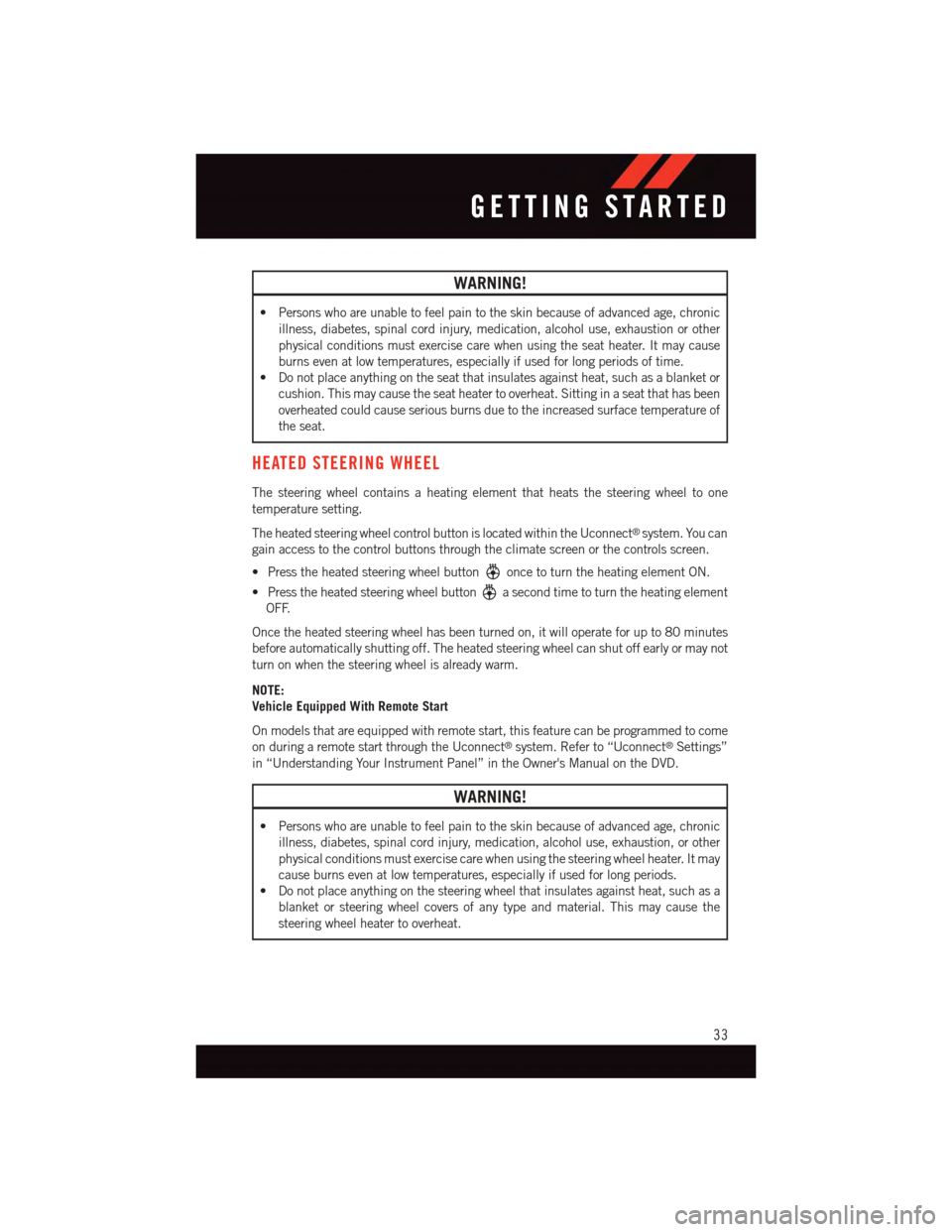
WARNING!
•Personswhoareunabletofeelpaintotheskinbecauseofadvancedage,chronic
illness, diabetes, spinal cord injury, medication, alcohol use, exhaustion or other
physical conditions must exercise care when using the seat heater. It may cause
burns even at low temperatures, especially if used for long periods of time.
•Donotplaceanythingontheseatthatinsulatesagainstheat,suchasablanketor
cushion. This may cause the seat heater to overheat. Sitting in a seat that has been
overheated could cause serious burns due to the increased surface temperature of
the seat.
HEATED STEERING WHEEL
The steering wheel contains a heating element that heats the steering wheel to one
temperature setting.
The heated steering wheel control button is located within the Uconnect®system. You can
gain access to the control buttons through the climate screen or the controls screen.
•Presstheheatedsteeringwheelbuttononce to turn the heating element ON.
•Presstheheatedsteeringwheelbuttonasecondtimetoturntheheatingelement
OFF.
Once the heated steering wheel has been turned on, it will operate for up to 80 minutes
before automatically shutting off. The heated steering wheel can shut off early or may not
turn on when the steering wheel is already warm.
NOTE:
Vehicle Equipped With Remote Start
On models that are equipped with remote start, this feature can be programmed to come
on during a remote start through the Uconnect®system. Refer to “Uconnect®Settings”
in “Understanding Your Instrument Panel” in the Owner's Manual on the DVD.
WARNING!
•Personswhoareunabletofeelpaintotheskinbecauseofadvancedage,chronic
illness, diabetes, spinal cord injury, medication, alcohol use, exhaustion, or other
physical conditions must exercise care when using the steering wheel heater. It may
cause burns even at low temperatures, especially if used for long periods.
•Donotplaceanythingonthesteeringwheelthatinsulatesagainstheat,suchasa
blanket or steering wheel covers of any type and material. This may cause the
steering wheel heater to overheat.
GETTING STARTED
33
Page 66 of 140
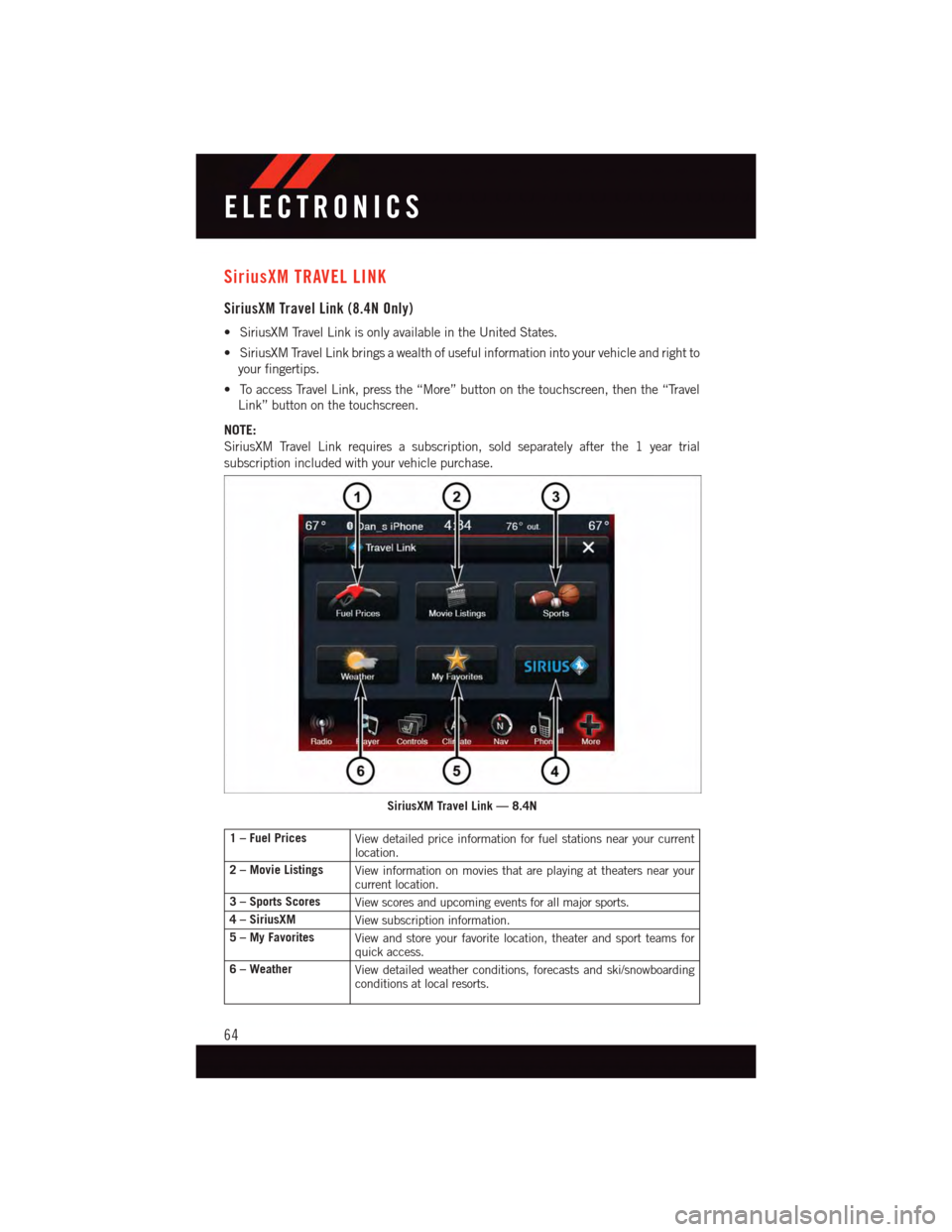
SiriusXM TRAVEL LINK
SiriusXM Travel Link (8.4N Only)
•SiriusXMTravelLinkisonlyavailableintheUnitedStates.
•SiriusXMTravelLinkbringsawealthofusefulinformationintoyourvehicleandrightto
your fingertips.
•ToaccessTravelLink,pressthe“More”buttononthetouchscreen,thenthe“Travel
Link” button on the touchscreen.
NOTE:
SiriusXM Travel Link requires a subscription, sold separately after the 1 year trial
subscription included with your vehicle purchase.
1 – Fuel PricesView detailed price information for fuel stations near your currentlocation.
2 – Movie ListingsView information on movies that are playing at theaters near yourcurrent location.
3 – Sports ScoresView scores and upcoming events for all major sports.
4 – SiriusXMView subscription information.
5 – My FavoritesView and store your favorite location, theater and sport teams forquick access.
6 – WeatherView detailed weather conditions, forecasts and ski/snowboardingconditions at local resorts.
SiriusXM Travel Link — 8.4N
ELECTRONICS
64
Page 94 of 140
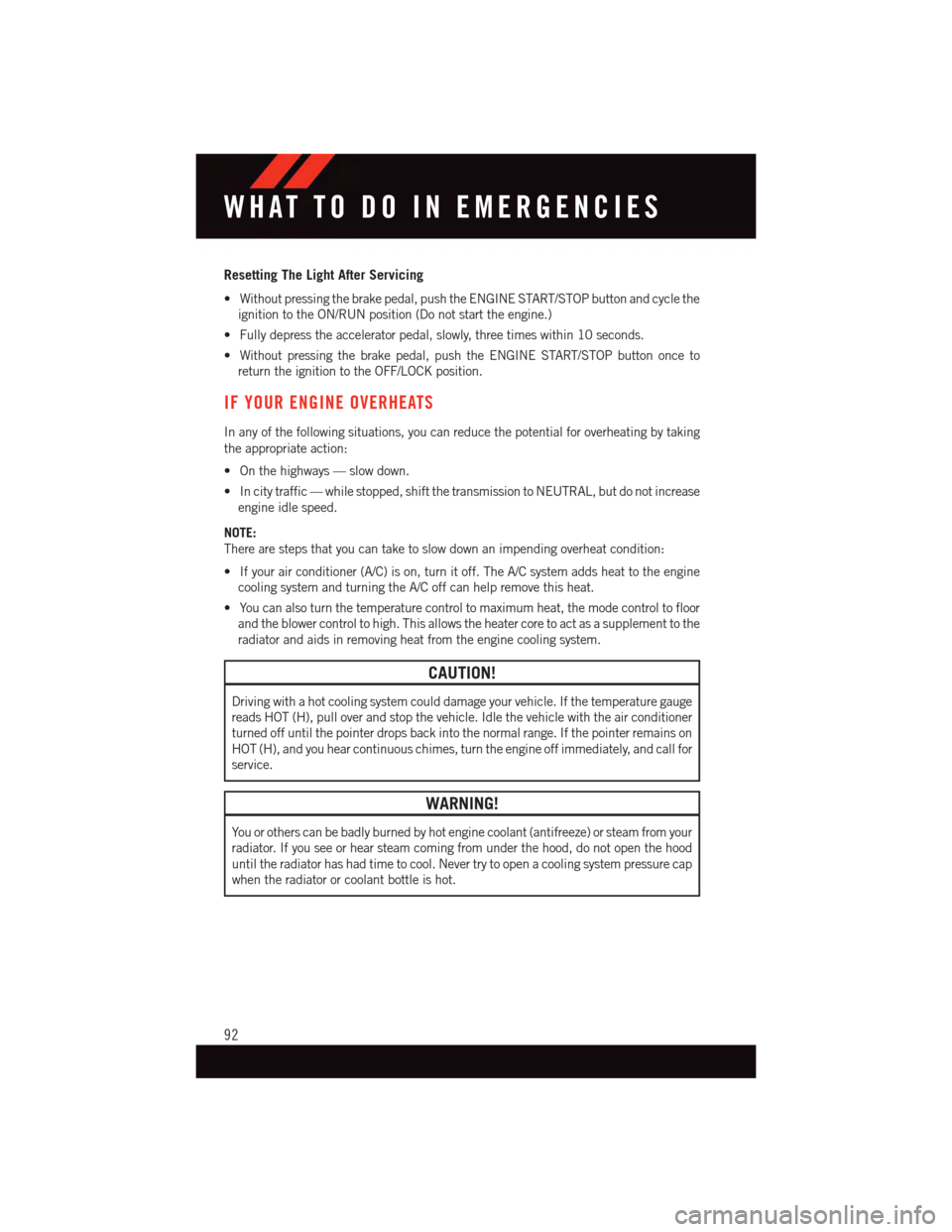
Resetting The Light After Servicing
•Withoutpressingthebrakepedal,pushtheENGINESTART/STOPbuttonandcyclethe
ignition to the ON/RUN position (Do not start the engine.)
•Fullydepresstheacceleratorpedal,slowly,threetimeswithin10seconds.
•Withoutpressingthebrakepedal,pushtheENGINESTART/STOPbuttononceto
return the ignition to the OFF/LOCK position.
IF YOUR ENGINE OVERHEATS
In any of the following situations, you can reduce the potential for overheating by taking
the appropriate action:
•Onthehighways—slowdown.
•Incitytraffic—whilestopped,shiftthetransmissiontoNEUTRAL,butdonotincrease
engine idle speed.
NOTE:
There are steps that you can take to slow down an impending overheat condition:
•Ifyourairconditioner(A/C)ison,turnitoff.TheA/Csystemaddsheattotheengine
cooling system and turning the A/C off can help remove this heat.
•Youcanalsoturnthetemperaturecontroltomaximumheat,themodecontroltofloor
and the blower control to high. This allows the heater core to act as a supplement to the
radiator and aids in removing heat from the engine cooling system.
CAUTION!
Driving with a hot cooling system could damage your vehicle. If the temperature gauge
reads HOT (H), pull over and stop the vehicle. Idle the vehicle with the air conditioner
turned off until the pointer drops back into the normal range. If the pointer remains on
HOT (H), and you hear continuous chimes, turn the engine off immediately, and call for
service.
WARNING!
Yo u o r o t h e r s c a n b e b a d l y b u r n e d b y h o t e n g i n e c o o l a n t ( a n t i f r e e z e ) o r s t e a m f r o m y o u r
radiator. If you see or hear steam coming from under the hood, do not open the hood
until the radiator has had time to cool. Never try to open a cooling system pressure cap
when the radiator or coolant bottle is hot.
WHAT TO DO IN EMERGENCIES
92
Page 103 of 140

JUMP-STARTING
•Ifyourvehiclehasadischargedbatteryit
can be jump-started using a set of
jumper cables and a battery in another
vehicle or by using a portable battery
booster pack.
•Jump-startingcanbedangerousifdone
improperly so please follow the proce-
dures in this section carefully.
NOTE:
When using a portable battery booster pack
follow the manufacturer's operating instruc-
tions and precautions.
Preparations For Jump-Start
•Thebatteryinyourvehicleislocated
between the left front headlight assem-
bly and the left front wheel splash shield.
To a l l o w j u m p - s t a r t i n g t h e r e a r e r e m o t e
battery posts located on the left side of
the engine compartment.
•Settheparkingbrake,shifttheautomatictransmissionintoPARKandturntheignition
to LOCK.
•Turnofftheheater,radio,andallunnecessaryelectricalaccessories.
•Removetheprotectivecoverovertheremotepositive(+)battery post. To remove the
cover, press the locking tab and pull upward on the cover.
•Ifusinganothervehicletojump-startthebattery,parkthevehiclewithinthejumper
cables reach, set the parking brake and make sure the ignition is OFF.
Remote Battery Post Locations
1—RemotePositive(+)BatteryPost2—RemoteNegative(-)BatteryPost
WHAT TO DO IN EMERGENCIES
101
Page 114 of 140
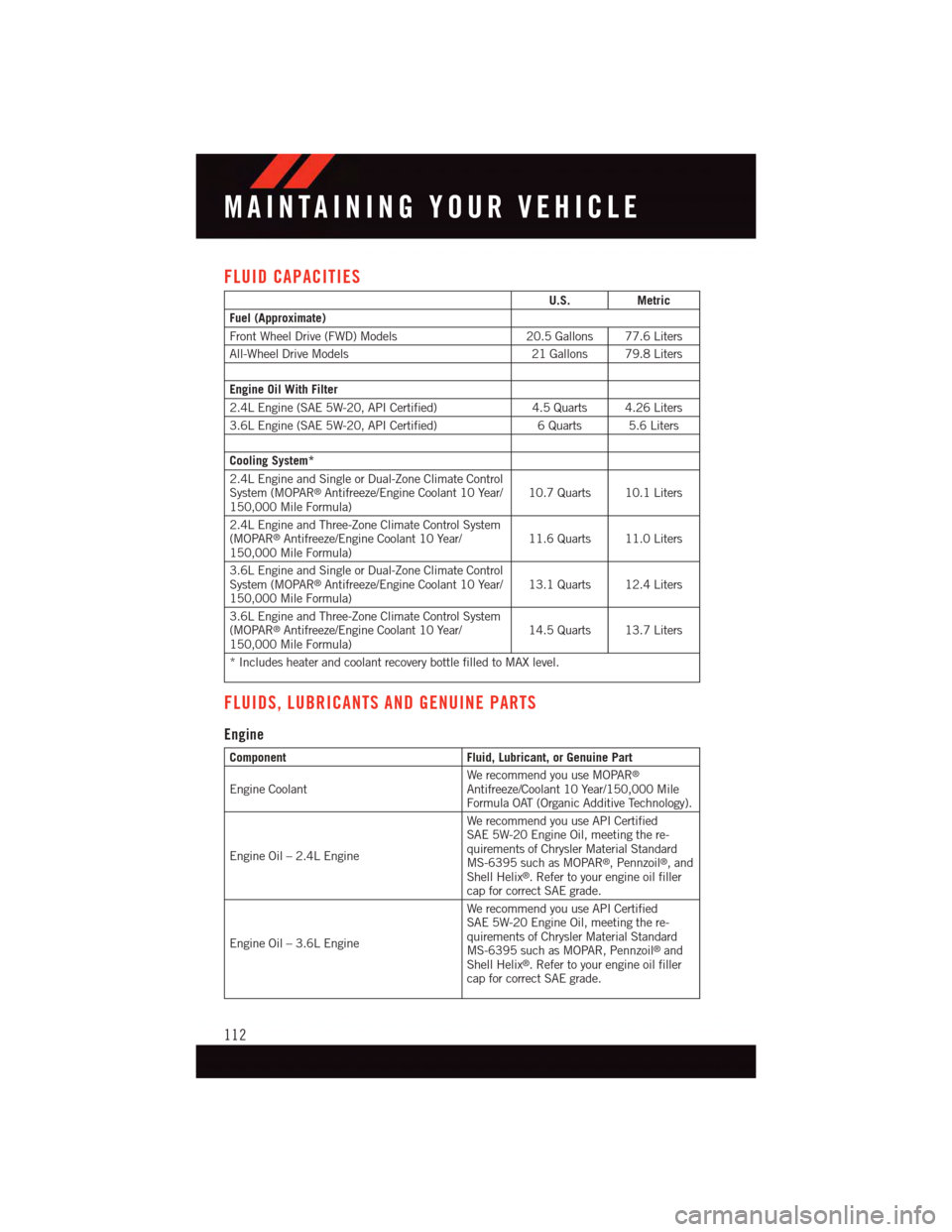
FLUID CAPACITIES
U.S.Metric
Fuel (Approximate)
Front Wheel Drive (FWD) Models20.5 Gallons 77.6 Liters
All-Wheel Drive Models21 Gallons 79.8 Liters
Engine Oil With Filter
2.4L Engine (SAE 5W-20, API Certified)4.5 Quarts 4.26 Liters
3.6L Engine (SAE 5W-20, API Certified)6Quarts 5.6Liters
Cooling System*
2.4L Engine and Single or Dual-Zone Climate ControlSystem (MOPAR®Antifreeze/Engine Coolant 10 Year/150,000 Mile Formula)10.7 Quarts 10.1 Liters
2.4L Engine and Three-Zone Climate Control System(MOPAR®Antifreeze/Engine Coolant 10 Year/150,000 Mile Formula)11.6 Quarts 11.0 Liters
3.6L Engine and Single or Dual-Zone Climate ControlSystem (MOPAR®Antifreeze/Engine Coolant 10 Year/150,000 Mile Formula)13.1 Quarts 12.4 Liters
3.6L Engine and Three-Zone Climate Control System(MOPAR®Antifreeze/Engine Coolant 10 Year/150,000 Mile Formula)14.5 Quarts 13.7 Liters
*IncludesheaterandcoolantrecoverybottlefilledtoMAXlevel.
FLUIDS, LUBRICANTS AND GENUINE PARTS
Engine
ComponentFluid, Lubricant, or Genuine Part
Engine CoolantWe recommend you use MOPAR®
Antifreeze/Coolant 10 Year/150,000 MileFormula OAT (Organic Additive Technology).
Engine Oil – 2.4L Engine
We recommend you use API CertifiedSAE 5W-20 Engine Oil, meeting the re-quirements of Chrysler Material StandardMS-6395 such as MOPAR®,Pennzoil®,andShell Helix®.Refertoyourengineoilfillercap for correct SAE grade.
Engine Oil – 3.6L Engine
We recommend you use API CertifiedSAE 5W-20 Engine Oil, meeting the re-quirements of Chrysler Material StandardMS-6395 such as MOPAR, Pennzoil®andShell Helix®.Refertoyourengineoilfillercap for correct SAE grade.
MAINTAINING YOUR VEHICLE
112
Page 122 of 140
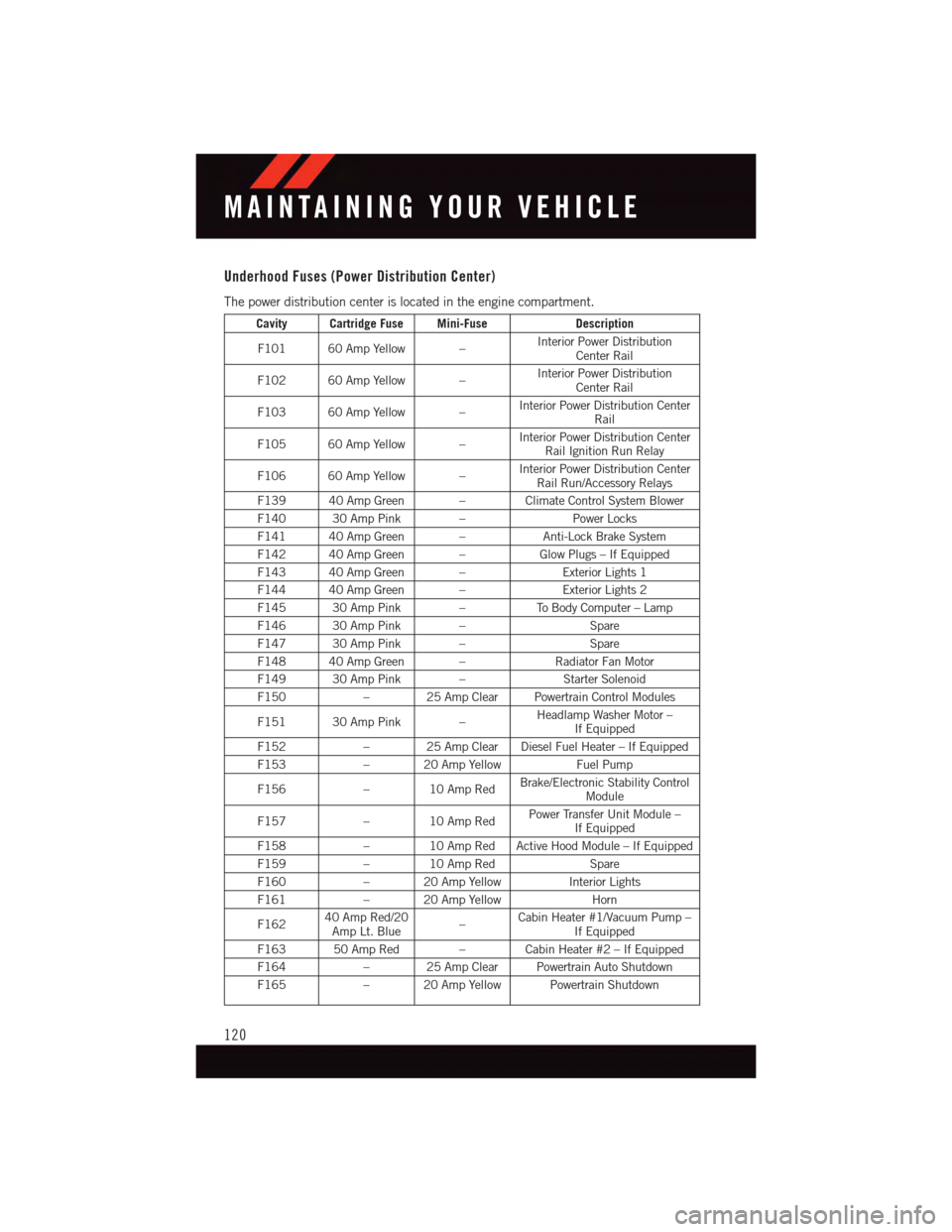
Underhood Fuses (Power Distribution Center)
The power distribution center is located in the engine compartment.
Cavity Cartridge Fuse Mini-FuseDescription
F101 60 Amp Yellow –Interior Power DistributionCenter Rail
F102 60 Amp Yellow –Interior Power DistributionCenter Rail
F103 60 Amp Yellow –Interior Power Distribution CenterRail
F105 60 Amp Yellow –Interior Power Distribution CenterRail Ignition Run Relay
F106 60 Amp Yellow –Interior Power Distribution CenterRail Run/Accessory Relays
F139 40 Amp Green – Climate Control System Blower
F140 30 Amp Pink –Power Locks
F141 40 Amp Green –Anti-Lock Brake System
F142 40 Amp Green –Glow Plugs – If Equipped
F143 40 Amp Green –Exterior Lights 1
F144 40 Amp Green –Exterior Lights 2
F145 30 Amp Pink –To B o d y C o m p u t e r – L a m p
F146 30 Amp Pink –Spare
F147 30 Amp Pink –Spare
F148 40 Amp Green –Radiator Fan Motor
F149 30 Amp Pink –Starter Solenoid
F150–25AmpClearPowertrainControlModules
F151 30 Amp Pink –Headlamp Washer Motor –If Equipped
F152–25AmpClearDieselFuelHeater–IfEquipped
F153–20AmpYellowFuel Pump
F156–10AmpRedBrake/Electronic Stability ControlModule
F157–10AmpRedPower Transfer Unit Module –If Equipped
F158–10AmpRedActiveHoodModule–IfEquipped
F159–10AmpRedSpare
F160–20AmpYellowInterior Lights
F161–20AmpYellowHorn
F16240 Amp Red/20Amp Lt. Blue–Cabin Heater #1/Vacuum Pump –If Equipped
F163 50 Amp Red – Cabin Heater #2 – If Equipped
F164–25AmpClearPowertrainAutoShutdown
F165–20AmpYellowPowertrainShutdown
MAINTAINING YOUR VEHICLE
120
Page 123 of 140
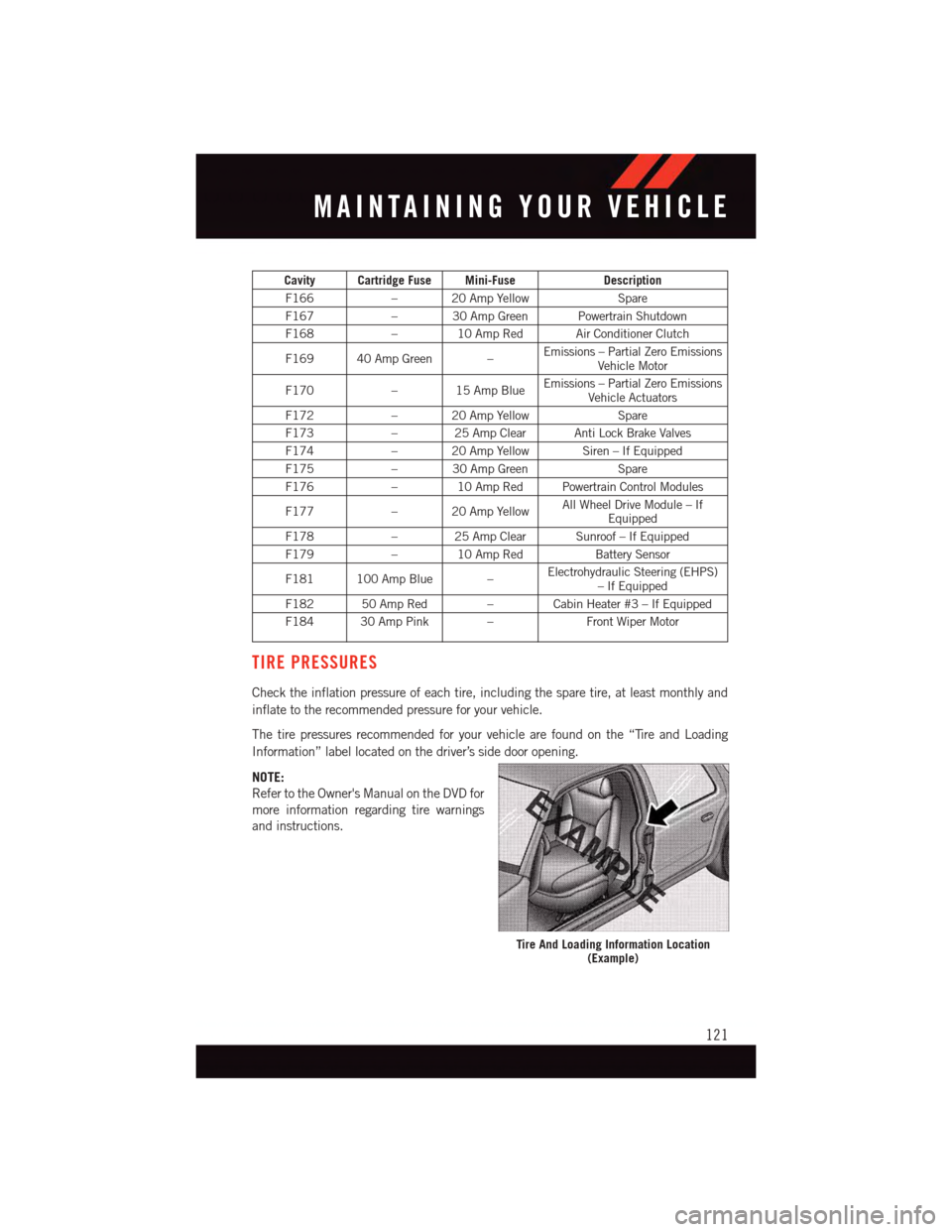
Cavity Cartridge Fuse Mini-FuseDescription
F166–20AmpYellowSpare
F167–30AmpGreenPowertrainShutdown
F168–10AmpRedAirConditionerClutch
F169 40 Amp Green –Emissions – Partial Zero EmissionsVehicle Motor
F170–15AmpBlueEmissions – Partial Zero EmissionsVehicle Actuators
F172–20AmpYellowSpare
F173–25AmpClearAntiLockBrakeValves
F174–20AmpYellowSiren–IfEquipped
F175–30AmpGreenSpare
F176–10AmpRedPowertrainControlModules
F177–20AmpYellowAll Wheel Drive Module – IfEquipped
F178–25AmpClearSunroof–IfEquipped
F179–10AmpRedBattery Sensor
F181 100 Amp Blue –Electrohydraulic Steering (EHPS)–IfEquipped
F182 50 Amp Red – Cabin Heater #3 – If Equipped
F184 30 Amp Pink –Front Wiper Motor
TIRE PRESSURES
Check the inflation pressure of each tire, including the spare tire, at least monthly and
inflate to the recommended pressure for your vehicle.
The tire pressures recommended for your vehicle are found on the “Tire and Loading
Information” label located on the driver’s side door opening.
NOTE:
Refer to the Owner's Manual on the DVD for
more information regarding tire warnings
and instructions.
Tire And Loading Information Location(Example)
MAINTAINING YOUR VEHICLE
121